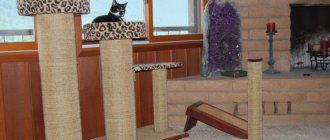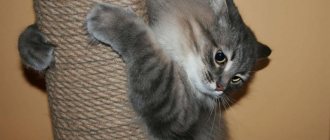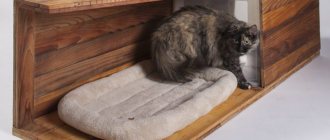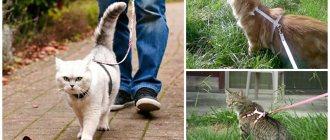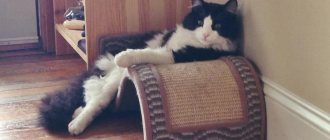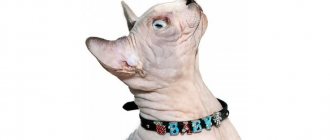Why does a cat need an outdoor enclosure?
For city residents, a trip to the dacha is associated with relaxation from the hustle and bustle, freedom and fresh air. If the family has pets, they will also be in for a journey and a change of scenery. Accustomed to confined spaces, cats find themselves in unknown, but so tempting territory; Their research instinct awakens and most animals are determined to explore the surrounding area. For a pet that is not accustomed to freedom, unexpected freedom can become a source of many troubles:
- The animal may run away and get lost.
- Contact with local old-timers can result in a fight , contracting a dangerous infection or an unwanted pregnancy.
- A valuable cat may be stolen .
Complete security Source fanvid-recs.com
- An animal can be hit by a car .
- The cat's instincts may kick in and she will start hunting for the neighbor's chickens - the owners' reaction may be unpredictable.
No matter how much you strive to protect your cat from the dangers of the outside world, you will not be able to keep it in the house all the time, depriving it of the joys of country life. Sooner or later, your pet will take a moment and slip out. The solution to all these problems has been around for a long time. An enclosure for cats in the country will balance the needs of you and your cats:
- You will calmly go about your business , and your long-awaited vacation will not be spoiled by a series of search and rescue operations.
- The pet will have the opportunity to spend the whole day outdoors in complete safety .
Fresh air and active games Source idei-dekoru.com
See also: Contacts of companies that provide metal structure installation services.
Necessity or whim?
By nature, our favorite furballs, namely cats, are predators. They need a lot of space to train and play. In this case, a cat enclosure is the optimal solution. Quite often, when constructing such structures, a separate place is allocated for the playing area. Loving cat owners create entire playgrounds and even towns, without spending money on expensive materials, but using only boxes.
Most people are accustomed to taking their animals to their dacha, where they move for the summer. And even if no problems arise during transportation, they may begin after arrival. Usually the problem appears in the form of neighborhood cats who ardently want to meet your kitty. After meeting the village folk, your pet may be rewarded with fleas and even unplanned offspring.
Another danger for pets is stray dogs and cars. According to statistics, animals that live primarily on the street live much shorter lives. This same chance is halved given the fact that your domesticated animal is unlikely to know what to do if attacked and what damage vehicles can cause.
Features of living space: secrets of choice
An enclosure is usually called a stationary outdoor structure, equipped with everything necessary for a pet’s long stay. The first enclosures for meowing pets appeared in North America; there, similar fenced courtyards received a special half-joking name - catio (by analogy with a patio, courtyard). The practical invention quickly spread throughout the world, although in our country it is still not a tradition, but an exotic one. For owners who are thinking about purchasing such a structure, there are recommendations to help them choose the best option. When choosing an aviary, think about the following things:
- Installation location . The best place is protected on one side by a house wall or fence - it’s more comfortable for the cat. If space allows, the structure is installed on a veranda or terrace.
There will be a place for owners too Source houzz.com
- Size . The larger the territory, the calmer and more confident the animal will feel. The fenced area should correspond to the number of pets, especially if you are purchasing an enclosure for kittens and a mother cat.
- Material . Domestic manufacturers offer collapsible structures without a floor on a wooden or metal frame, covered with PVC-coated welded mesh.
- Roof . It not only protects a nimble animal from escaping, but also serves as protection from bad weather and direct sunlight. A flat roof should have a slight slope; the presence of a drain to eliminate puddles on the floor is welcome.
Project with a roof Source ydachadacha.ru
How to do it yourself
We will advise you on how to make a fence for a cat in your country house or on the site of a country house with your own hands. First you need to decide on the size and location. The minimum dimensions of such a pen for one cat should be 2x3 meters. We will make the enclosure from metal pipes with a diameter of 1 inch. A fine mesh netting is suitable for walls.
Design requirements
Such an enclosure must comply with all sanitary standards. Even with the smallest dimensions, it must provide space for a toilet tray, a container for food and fresh water. Installing a small house for cats to rest is encouraged. You can equip the interior space with a playground with stairs and multi-tiered shelves, toys tied to them, numerous labyrinths and a place for hiding, and hammocks.
All listed items must be made from natural materials, and wooden products are not recommended to be painted or varnished. Carry out the treatment with special means.
Tools and materials
What materials will be needed when making an aviary:
- metal pipe;
- chain-link mesh, wire to strengthen it;
- wooden beam;
- slate, slate nails;
- self-tapping screws;
- cement, sand, crushed stone.
Tools:
- shovel;
- welding machine;
- drill;
- screwdriver;
- plumb line
Step-by-step instruction
- Mark the dimensions of the enclosure on the selected area, according to the chosen plan, and dig holes around the perimeter at a distance of 1–1.5 meters for installing posts - metal pipes. The length is selected taking into account the roof slope. Provide space for an entrance gate.
- Insert pre-cut posts of a certain length into the holes, strengthen them vertically with crushed stone and concrete.
- We weld the same pipes onto the upper parts of the posts around the perimeter. The roof frame is ready.
- We install the mesh using wire and welding.
- We attach a wooden beam to the upper frame with self-tapping screws.
- All that remains is to lay the slate, securing it securely with slate nails.
- We make a gate separately and hang it on one of the posts using welded hinges, not forgetting about its secure fixation (latch).
- The design of the floor can be different, in our case it is lawn grass. Other options: pea gravel, poured concrete, paving slabs, boardwalks, untreated natural stone walkways.
We made an enclosure using mesh for the walls. We offer another option - to build a similar enclosure next to the country house. Then the wall of the house with the window will simultaneously serve as one of the walls of the enclosure. The animal will have an unhindered opportunity to enter and exit home through the window.
Variety of models
Stationary design Source pinterest.com
Grand decision Source hatchfest.org
Aviary with a wooden frame Source idei-dekoru.com
With a combined floor Source idei-dekoru.com
Loft style Source pinterest.com
The aviary can fit into any landscape Source pinterest.com
Carrying with your own hands
To save on buying an expensive carrier, you can sew a travel cage with your own hands in 2 hours. To work you will need:
- Thick fabric for the top.
- Lining fabric.
- Plastic bottom.
- Net.
- Lightning.
- Finished pen-tape.
This model consists of 4 parts: bottom, side parts, top and handle. The bottom is a rectangle corresponding to the length of the pet. It is better to sew it from thick fabric in combination with a lining. To add rigidity, durable plastic is inserted into the bottom part. The semi-oval sides should coincide with the height of the animal, so that the cat can comfortably stand up to its full height. Then you need to sew a zipper along the edge of one of the side panels and stitch mesh inserts to them. It is worth sewing a handle to the rectangular top of the carrier and assembling the parts into a single structure. Decorate as desired.
Ready-made enclosures
Pet stores probably have a wide range of enclosures for cats. Their cost is considerable. But the finished product allows you to introduce pets into it immediately after installation of the structure. The most popular designs are:
Deluxe Cat Home
Produced in the USA, the initial cost is 7,500 – 7,800 rubles*. Suitable for installation inside residential buildings and apartments. They can also be installed as temporary structures for exhibitions of breed animals. The structures are mobile because they are equipped with wheels, and also have multi-level play areas, hammocks and seats. Designed for 2 adult animals.
Trixie Cat Homes
It was invented and manufactured in the USA; it is a wooden case covered with mesh. Can be used outdoors. The peculiarity of the building is that it is equipped with unusual holes, where the cat can hide if she wants privacy. The initial cost starts from 32,000 rubles.
Making your own enclosure
Such structures are rare in markets. It's just that not everyone needs it. However, making it with your own hands is not as difficult as it might seem at first glance. The main thing is to choose the right tools and materials.
What will you need?
To create a house for a cat, you will need:
- Net.
- Reiki. The best option would be wood material.
- Nails. It is best to purchase self-tapping screws.
- Hinges for doors.
- Cement. Roofing iron is also suitable, with which you can strengthen the bottom, preventing the possibility of undermining.
- Door lock.
- Lining.
Grid selection
The grid may be different. It is important to select the material based on a specific situation.
The following options should be considered:
- Chainlink. Not an optimal solution for an enclosure. It is created by weaving the wire in a certain way. In this case, the rods are not welded to each other at the places of overlap. For this reason, a cat can damage its paws if it climbs on the net.
- Woven. This material is not suitable for an enclosure for the same reasons as chain-link. Although the weaving method is different, the rods are not welded to each other.
- Welded. The best option for an enclosure, since the rods are welded to each other. Sometimes the mesh is coated with polymers. Due to this, the material acquires corrosion resistance.
- All-metal expanded metal mesh. This is a metal sheet in which special diamond-shaped cells are cut. It is usually used in plastering work as a reinforcing material. Not suitable for an aviary.
Selecting slats and creating doors
After choosing a specific mesh, you will need to purchase wooden slats. It is recommended to paint them before use. From this material you need to make a frame for the mesh.
If it was decided to attach the enclosure to the house, it is necessary to make a door. One will be enough. If the structure will stand separately from the house, it is recommended to provide a special vestibule for the pet. It will prevent the cat from running out when the owner exits the door. In such a situation, there should be two such elements - from the street to the vestibule and from the vestibule to the enclosure.
Pet house
If you decide to build a large structure, provide a small house for your pet. It will provide shelter from rain or extreme heat. There are several options. You can build a house in the shape of a doghouse. It is worth placing it on a small pedestal so that the pet has to climb into it.
Also, a house for a cat can be large, human-sized. To create it, you can use lining.
Creating a floor
If you want your cat to walk on the grass, there is no need for flooring. However, it will be necessary to strengthen the enclosure around the perimeter. This will help prevent undermining. Cement should be poured along the mesh, using the boards as a frame. They can be removed after the cement has hardened.
You can simply bury the mesh about 20 cm into the ground. It is possible to use roofing iron, having previously cut it into small strips. This material should be driven into the ground around the perimeter of the enclosure.
If the cat is not supposed to walk on the ground, you will need to think about flooring. You can use materials to create it such as wood, cement and tiles. They all have advantages and disadvantages. For example, cement and tiles are more durable materials. However, in bad weather, your pet's paws will freeze.
Creating a ceiling
The ceiling is usually made of mesh. However, keep in mind that it should be shallow so that snow does not fall through it in winter. Since there can be a lot of it, the ceiling must be strong enough and durable.
What does a standard design look like?
DIY enclosure for alabai: dimensions
Enclosures are divided into outdoor and indoor. If you need to separate space in an apartment or house, then simply install a partition. Residents of private and country houses are recommended to give preference to spacious structures on the streets that resemble cat estates. As a rule, they are equipped with several types of multi-level play areas.
Important! Due to the changeable climate, it is not permissible to keep a pet outdoors all the time. Such structures are suitable only as a seasonal or temporary measure.
Home enclosure for cats
Aviary for cats in the country
The long-awaited summer has arrived, the summer season begins. We are looking forward to the weekend to go to the country and take our pets with us. We want not only to enjoy the fresh air and the gentle sun ourselves, but also to do something nice for our cats. Before you go to the country with your animal, be sure to visit a veterinarian and get an annual preventive vaccination. Read how to prepare a cat for the dacha here >>>.
Why do you need an enclosure for cats in the country? After all, it is generally accepted that a cat walks on its own; it does not need a leash or a cage. Cats living in the village do not need this. From kitten age, they know their territory and have the skills to survive in the environment. A domestic cat, especially a purebred cat, is another matter. Although no one has canceled the innate instincts, in the conditions of a city apartment, they are dulled. Remember, a cat faces many dangers on the street - stray dogs, neighbor's cats, rodents that are carriers of dangerous diseases. Therefore, caring owners of four-legged pets build an enclosure for cats on their summer cottage.
Of course, you can keep cats in the house, as well as in a city apartment. But at the dacha, my elderly parents often forget to close the front door, and the cats are still on duty near it. At the first opportunity they run out into the street, there are so many interesting things around - the sun is shining, flies and birds are flying. With an aviary, there is no need to be afraid that our furry pets will accidentally run away from home. In the enclosure you can observe life happening around. Of course, this is a limitation of space for the cat. But in the city, our pets are also limited to the confines of an apartment, albeit larger than an enclosure. But in the enclosure, the cat can observe life from the outside and breathe fresh air. And if you buy a harness, you can take her for a walk on the green grass. You will learn what types of harnesses there are and how to train a cat to walk on a harness by reading the article Harness for cats.
In 2021, we started a grandiose construction project at the dacha. Along with adding a kitchen to the house, a utility block and an enclosure were built. I thought for a long time about how to place several buildings on six dacha acres. As a result, they decided to make the outbuildings and the enclosure into a single building. It turned out very convenient. The entrance to the enclosure was made not from the street, but inside the utility unit, in case when the door was opened, one of our pets decided to escape.
This is the kind of construction we ended up with.
The first time we took our cat and male cat with us to explore a new enclosure was during the June holidays. The weather was good, the sun was shining and it was quite warm. Our enclosure was not yet fully equipped. There were still no shelves on which you could jump or just sit, watching what was happening from the outside, the floor was not equipped, we had not yet laid linoleum on it, and the walls were not lined with clapboard. Therefore, we took with us from home a scratching post-house, in which two cats can easily hide.
Any change of environment for a cat is very stressful. I can’t say that the cats were delighted with our idea of placing them in an enclosure. They immediately hid in their house. Even the cat’s fat butt quickly disappeared into the hole.
On the first day, our pets got used to the change of environment, they were frightened by unfamiliar sounds from the outside, and only after making sure of their safety did they begin to show interest in their surroundings. The cat turned out to be bolder; perhaps female curiosity overcame fear. She went out and began to examine the new home.
After some time, the cat came out. He carefully looked and sniffed everything around, but when he heard the steps of daddy’s feet shuffling in rubber galoshes, he quickly hid back.
During the day, our cats did not touch food or water, and did not go to the toilet, sitting most of the time in their shelter. At night, I covered the enclosure mesh with a covering sheet for beds, which allows air to pass through but protects from the wind and various midges and mosquitoes.
Apparently at night, when everything around was quiet, the cats felt calmer. They ate the food left for them and did all their business in the tray.
In the morning, when we approached the enclosure, they came out to greet us.
On this day we went to explore the open space outside the enclosure.
And then we had a little photo shoot
Soon our pets got used to walking in the enclosure, and sitting comfortably on the shelves, they rested during the day.
And in the evening we took them into the house.
Share with your friends!
kentstart.ru
